 | |||
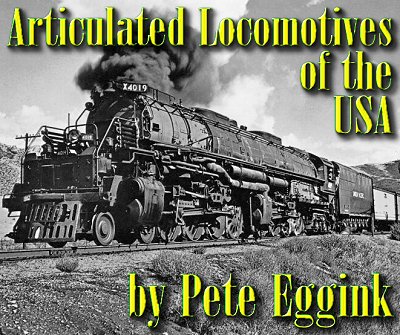 |
 |
 | |
 |
 | ||
 |
 | ||
 |  | ||
 |  | ||
 | |||
 |
 |
 | |
 |
 | ||
 |
 | ||
 |  | ||
 |  | ||
| Written by Paul D. Race for Family Garden Trains(tm)
and New Boston and Donnels Creek: |
 |

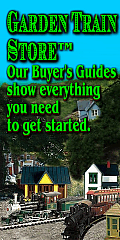
|
Note from Editor: The core of this article appeared in the South Eastern Pennsylvania Garden Railway Society newsletter in September, 2004. Like the SEPGRS Introduction to Mallets article I posted the previous month, this one seemed timely in light of current manufacturer offerings. Update for 2022: Sadly, since this article was published, most of the model articulated locomotives featured near the bottom of this article have been discontinued and are nearly impossible to find. But we are leaving this page up because the general knowledge about these behemoths will be valuable for anyone interested in modeling steam in the future. Thanks go out to Pete Eggink for allowing us to republish this fine contribution. - Paul Articulated Locomotives of the USA by Pete EgginkAs America’s railroads grew over the years, trains got longer and locomotives got bigger. The longer a train, the more productivity they could get out of each crew. In 1904, the B&O found a way to get twice the power in a single locomotive, by combining two engine mechanisms under the same boiler. This new type of locomotive was called a Mallet. It revolutionized mountain railroading by pulling longer trains up the hills with far lower crew costs. Before we get confused with terms, let’s cover a few definitions:
 MalletsThe first successful Mallet in the U.S. was B&O’s 0-6-6-0 of 1904. Its success drove many railroads to order Mallets for pulling longer and longer trains. This was the “drag freight” era for railroads, where speed was not as important as train length, and the Mallet fit in nicely. Several ideas were tried to increase power, efficiency, and speed. The Erie tried a 2-8-8-8-2 and the Santa Fe tried flexible boilers. Neither idea worked. In 1919 the Virginian ordered a set of 2-10-10-2’s that was very successful, and had the highest starting tractive force of any steam locomotive ever, 176,600 pounds.Even with large and efficient Mallets, the railroads found a few drawbacks: 1) back pressure caused the front cylinders to lose efficiency over 15-20 mph, 2) the large cylinders and small wheels limited counterweights to balance wheels at lower speeds, and 3) the huge front cylinders meant the railroads needed larger tunnel clearances. Therefore the Mallet was best at pulling and pushing long trains at low speeds. The Norfolk and Western had plenty of need for high-power low-speed locomotives, so they continued to develop their Mallets into successively better locomotives right up to the late 1950’s. One version, the Y-3, was chosen as the basis for Aristocraft’s Mallet locomotive. The photo below shows an N&W Y6B, their last iteration of this class, and one that - as I understand it - was used by other railroads like PRR during and after WWII.  Not all Mallets were used for mainline freight operations. The Erie railroad had three camelback Mallets, apparently used for heavy switching operations.  Simple ArticulatedsIn 1919 the Pennsylvania Railroad designed a large Simple Articulated that was ahead of its time: when it was used at the front of a train, it broke the couplers far too often. A few years later, in 1924, a tunnel-clearance problem convinced the C&O to try a Simple Articulated with the same basic size of a Mallet but with smaller front cylinders. The concept worked well. Then the Great Northern built a Simple Articulated with larger drivers that could run at much higher speeds. Now the true value of a Simple Articulated was recognized: high power and faster speed. Several railroads, including the Reading and B&O, converted their existing Mallets into Simple Articulateds.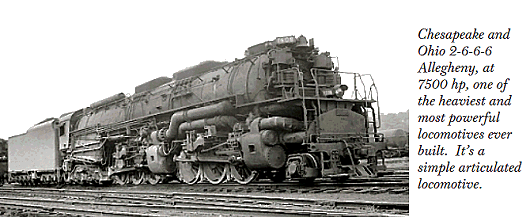 Others developed new designs that were larger and faster. The Southern Pacific had a problem with smoke and fumes choking engine crews in tunnels. It solved it by building Simple Articulateds with the cab in the front (Cab Forwards). An example 2-8-8-2 cab forward is shown below. 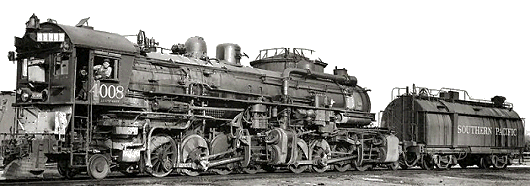 The quest for high power and high speed culminated in the Union Pacific’s Big Boy (below), a huge 4-8-8-4 that could run 70 mph with heavy trains. 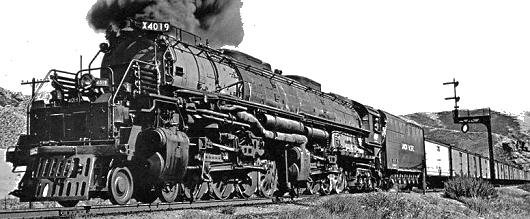 Four-cylinder Non-articulated EnginesIn the 1940’s the Pennsylvania Railroad experimented with the idea of building engines with four pistons instead of two, so that the reciprocating machinery could be lighter and thus capable of higher speed. They were huge and powerful and looked like articulated engines, but actually had a rigid wheelbase. The freight version was the Q-2 4-4-6-4, the longest and most powerful steam locomotive in the world. The passenger version was a 4-4-4-4, known as the T-1, a handsome and fast engine, easily capable of 100 mph. They were not considered a successful design because of maintenance problems; and they were all retired within 6 years. Steam Turbine LocomotivesSeveral coal-hauling railroads attempted to develop new types of locomotives to use coal as fuel. The Pennsy tried with a locomotive that had a turbine mounted directly to the running gear. The Norfolk and Western tried with the “Jawn Henry,” in which the steam turbine powered a generator which sent power to traction motors at the wheels. The C&O designed a small fleet of similar steam-turbine-electrics. None of these designs worked well enough to compete against the diesel-electric locomotives that were already replacing steam.Famous Articulated LocomotivesUnion Pacific’s Big Boy is often called the largest locomotive ever built, but even if it wasn’t the biggest, it was certainly one of the best. Several are on display, including one at Steamtown.Union Pacific’s Challenger 4-6-6-4 was just as fast, although not quite as large or powerful. Challenger #3985 is still running specials for the U.P., and is based in Laramie, Wyoming. Norfolk and Western’s Class A 2-6-6-4 was a fast, powerful, efficient locomotive used for both freight and passenger trains. Number 1218 ran steam specials until a few years ago. The Norfolk and Western’s Y-class (2-8-8-2) and A-class (2-6-6-4) locomotives were featured in many fine photographs taken by O. Winston Link in the 1955-1960 era. The Southern Pacific owned more articulateds than anyone else, 207, including 195 Cab Forwards. Chesapeake and Ohio’s tough-looking Allegheny 2-6-6-6 was possibly the most powerful steam locomotive ever built. One is on display at the B&O Museum in Baltimore. Example Models of Articulated LocomotivesHO and N have had many mallet models for decades, including Big Boys, and 2-8-8-2s patterned after the N&W Y-series engines. But since my pages serve mostly O scale and larger modelers, here are some articlulated models worth your consideration. Some of them can be hard to come by, as they come in and out of production. But they're all really big fun.Large Scale (Garden Train) Articulateds - Narrow GaugeThe following three locomotives are available in scales running from 1:20.3 to 1:22.5, suitable for modeling narrow gauge industrial or short-line railroads outdoors.
Large Scale (Garden Train) Articulateds - Standard GaugeThe following locomotives represent several "common carrier" mainline locomotives that kept up regular operations as late as 1960 on major railroads across the country. They range from 1:29 to 1:32 in scale and are suitable for modeling really big railroads. Hope you have room for really big curves. 10'-diameter curves are the minum, but they all look better on 15'- or 20'-diameter curves.
On30 Articulateds
Note: Several of the Bachmann On30 articulated locomotives are currently being offered at discount by vendors at Amazon. I have provided links near the bottom of this page. O Gauge Articulateds
New On30 ModelsThe following Amazon links take you to some of the Bachmann On30 2-6-6-2 models to help you see what variety is available.
|
|

| 
|
 |
 |
 |
 |
 |
Note: Family Garden TrainsTM, Garden Train StoreTM, Big Christmas TrainsTM, BIG Indoor TrainsTM, and BIG Train StoreTM are trademarks of Breakthrough Communications (www.btcomm.com). All information, data, text, and illustrations on this web site are Copyright (c) 1999, 2000, 2001, 2002, 2003, 2004, 2005, 2006, 2007, 2008, 2009, 2010, 2011, 2012, 2013 by Paul D. Race. Reuse or republication without prior written permission is specifically
forbidden.
Family Garden Trains is a participant in the Amazon Services LLC Associates Program, an affiliate advertising program designed to provide a means for sites to earn advertising fees by advertising and linking to amazon.com.
For more information, please contact us

 |  |